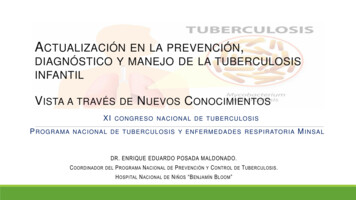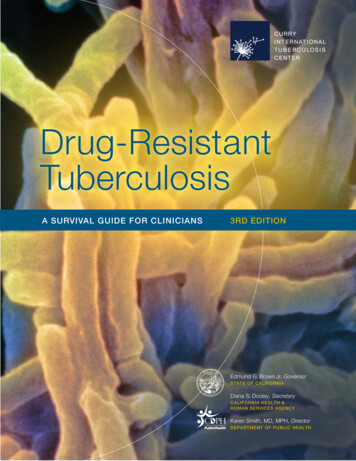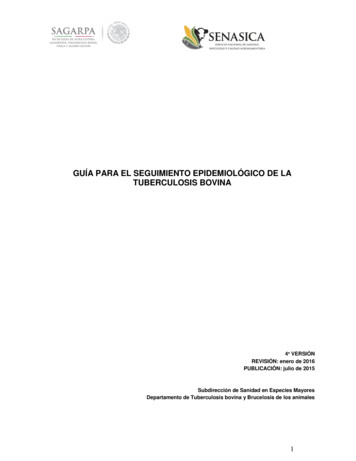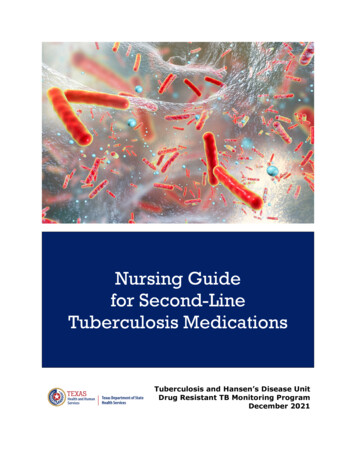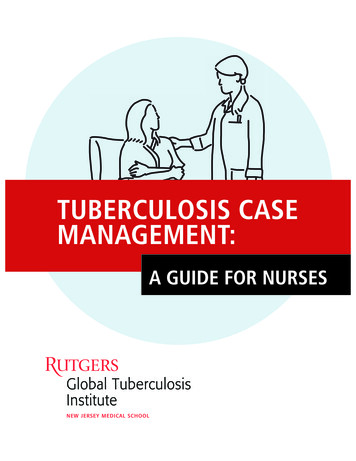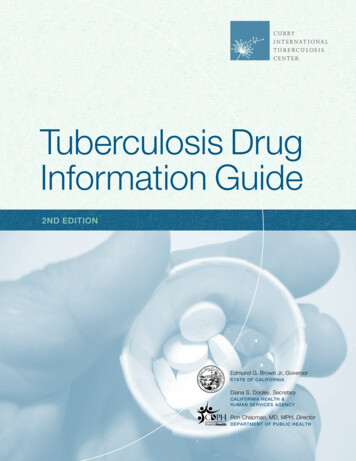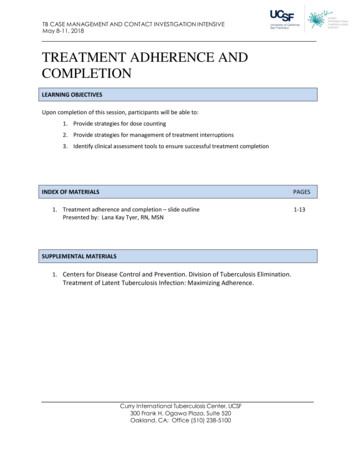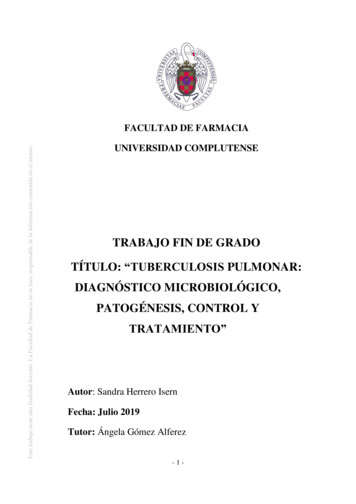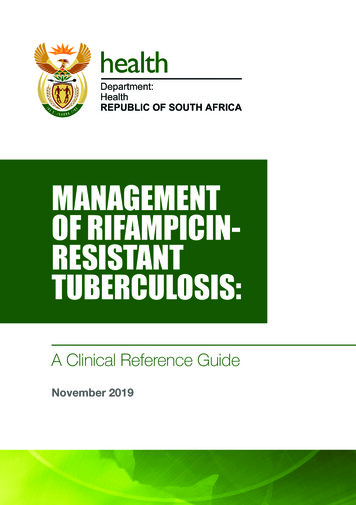
Transcription
MANAGEMENTOF RIFAMPICINRESISTANTTUBERCULOSIS:A Clinical Reference GuideNovember 2019
TABLE OF CONTENTSAcknowledgements11Definitions12-13Brief Introduction14Organisation of Services18Roles of the PCACs and NCAC20Summary of Diagnosis22Diagnosis of RR-TB in Children28-29The Shorter Regimen for RR-TB: Summary Points30-31Principles of the Shorter Treatment Regimen in Children Aged 6 Yearsand Above35Shorter Regimen Summary36Switching from Shorter Regimen to Longer Regimen38Longer Regimens for RR-TB: Summary Points39-40Inclusion Criteria for Longer Regimens44Principles of Longer Treatment Regimens in Children Under the Age of6 Years50-523
Rescue Regimens: Summary58Approach to Designing Rescue Regimens or Regimens for Patients withRR-TB and Suspected or Confirmed Resistance to Linezolid, Clofazimineand/or Bedaquiline59-60RR-TB in Pregnancy and Breastfeeding62-63Summary Principles on HIV and RR-TB Co-Infection64Antiretroviral Therapy in HIV-Infected Persons with RR-TB65-66Management of Antiretroviral Therapy in Persons with RR-TB68-71Summary Principles for Monitoring and Management of Adverse Events77Adverse Event Screening Questionnaire80Management of Haemoglobin 8.0 g/dL88-91Management of Patients with QT Interval Prolongation92-93Management of Patients with Peripheral Neuropathy94Management of Patients with Hepatotoxicity95Summary Activities for Active Drug Safety Monitoring97-98Contact Evaluation and Post-Exposure Management: Summary1004
Rifampicin Resistant TB Patients Household Contacts105-107Drug-Resistant TB that is not Rifampicin-Resistant: summary110Management of Drug-Resistant TB that is not Rifampicin-Resistant111Summary of Patient Support Strategies112Summary Points on Palliative and End-of-Life Care117Summary Points on Post-Treatment Follow Up1185
LIST OF TABLESAbbreviations9-10Summary Table of Major Guideline Changes15-27Types of Laboratory Testing and Estimated Turnaround Times23Interpretation of Laboratory Test Results for Persons Started on theShorter Regimen Based on GeneXpert Rifampicin Resistance25Laboratory Testing: Special Situations27Inclusion and Exclusion Criteria for the Shorter Regimen32-33Rationale for Modification of Medications in the Shorter Regimen37WHO Drug Groupings and Steps to Designing a Longer TreatmentRegimen42-43Longer Regimens for Persons Aged 6 Years and Above45Recommended Dosing of Drugs for RR-TB Treatment in Persons 6 Yearsand Weighing 30 kg46-47Renal Dose Adjustments For Adults48-49Sample Longer Regimens in Children Under the Age of 6 Years53Weight-Based Dosing Recommendations for Children 6 Years andPersons Weighing 30 kg54-57Special Considerations for Persons on Longer Regimens61Assessment of Renal Function Prior to Starting Tenofovir-Based ARTRegimens676
ART Modifications For HIV-infected Persons Aged 10 Years andWeighing 35 kg and on ART When RR-TB Treatment is Initiated72ART Regimen Modification for HIV-infected Children Aged 10 Years orWeighing 35 kg and on ART at RR-TB Treatment Initiation73Overlapping Toxicities between ART and RR-TB Treatment74Management of RR-TB and Other Co-Morbidities75-76Summary Monitoring Table78-79Summary Table on Identification and Management of Key Adverse Events81-87Drug Substitution or Extension for Toxicity Management96Severity Rating Scale for Adverse Events99Definitions Used in Contact Evaluation and Post-Exposure Management101Management Steps for Contact Evaluation and Post-ExposureManagement103-104Medicines to be considered for Treatment of RR-TB infection108Patient Categories and Treatment Outcomes for TB Preventative Therapy109Treatment Outcome Definitions for the Shorter Regimen113-114Treatment Outcome Definitions for Longer Regimens115-116Summary Points on Post-Treatment Follow Up1187
LIST OF DIAGRAMSOrganisation of Services: Patient Flow19Overall Flow Diagram21Laboratory Reflex Testing Workflow24Extended DST Request26Initial Approach to Patients Diagnosed with RR-TB34Initial Approach to Longer Regimens41Overall Approach to RR-TB Post-Exposure Management1028
ABBREVIATIONSaDSMActive Drug Safety Monitoring and ManagementARTAntiretroviral TreatmentBDQBedaquilineCNSCentral Nervous SystemCFZClofazimineDLMDelamanidDR-TBDrug Resistant TuberculosisDSTDrug Susceptibility TestEMBEthambutolECGElectrocardiogramEDSTExtended Drug Susceptibility TestEPTBExtra-Pulmonary TuberculosisEFVEfavirenzETOEthionamideFBCFull Blood CountFLQFluoroquinoloneGXPGeneXpertHIVHuman Immunodeficiency VirusHR-TBIsoniazid resistant tuberculosisINH / hdINHIsoniazid/ high-dose IsoniazidINJInjectable agentIRISImmune Reconstitution Inflammatory SyndromeKMKanamycinLFXLevofloxacinLPALine Probe Assay9
LZDLinezolidMICMinimum Inhibitory ConcentrationMOMedical tional Clinical Advisory CommitteeNDoHNational Department of HealthPCACProvincial Clinical Advisory CommitteePHCPrimary Healthcare ce UnitQTcCorrected QT intervalRIFRifampicinRRRifampicin ResistantSAPHRASouth African Health Products Regulatory AuthoritySCRShorter Course RegimenSLDsSecond-Line Tuberculosis DrugsTRDTerizidoneXDRExtensively Drug ResistantWHOWorld Health OrganizationPZAPyrazinamide10
ACKNOWLEDGEMENTS Dr Francesca ConradieProf Gary MaartensProf Graeme MeintjesProf Ebrahim VariavaProf Nazir IsmailDr Iqbal MasterDr Rodolfo RomeroDr Jenny HughesDr Jennifer FurinDr Vivian CoxDr Hannetjie FerreiraDr Martin EnweremDr Patrick HazangweDr Julian te RieleMrs Yulene KockDr Anja ReuterDr Xavier PadinalamMrs Nirupa MisraWe thank the World Health Organization and the USAID Office based in South Africafor financial support that enabled the production of this handbook. All provincialTB and DR-TB Managers and DR-TB facilities staff are thanked for supporting thiswork. The Aurum Institute is also acknowledged for support to the DR-TB directorateactivities.This document is a revision of the interim guidance published in September 2018.Dr Jennifer Furin, Dr Vivian Cox and Dr Jenny Hughes are thanked for the revision.Members of the NCAC endorsed the final document.Development of this handbook was co-ordinated by Dr Norbert Ndjeka with supportby Dr Anja Reuter and Dr Jenny Hughes.Reproduction of this publication for commercial distribution is prohibited. Requeststo reprint this publication should be addressed to the Director drug-resistant TB, TB& HIV; National Department of Health available on Norbert.Ndjeka@health.gov.za orP/bag X828, Pretoria 0001, South Africa.11
DEFINITIONSDrug-resistant tuberculosis (DR-TB) refers to active tuberculosis disease caused byMycobacterium tuberculosis bacilli that are resistant to one or more anti-TB drugs.Different categories:Mono-resistant TBResistance to only one anti-TB drug, without resistance to other drugsPoly-drug resistant TBResistance to more than one anti-TB drug, other than both isoniazid and rifampicinMultidrug-resistant TB (MDR-TB)Resistance to isoniazid and rifampicin with or without resistance to other anti-TB drugsRifampicin resistant TB (RR-TB)Resistance to at least rifampicin, with or without resistance to other drugs. Thiscategory includes MDR-TB, rifampicin mono-resistant TB, pre-XDR-TB and XDR-TB.Extensively drug-resistant TB (XDR-TB)MDR-TB with resistance to any fluoroquinolone as well as one or more of the threesecond-line injectable drugs (amikacin, kanamycin or capreomycin). Given that SouthAfrica is moving away from the routine use of the injectable agents, this term mayhave limited clinical relevance. When possible, resistance to individual medicationsused in the newly recommended regimens should be specified, including resistanceto bedaquiline, clofazimine, delamanid and/or linezolid.Pre-XDR-TBMDR-TB with additional resistance to either a second-line injectable agent or afluoroquinolone. Given that South Africa is moving away from the routine use of theinjectable agents, this term may have limited clinical relevance and it may be moreappropriate to refer instead to fluoroquinolone-resistant RR-TB. However, pre-XDRTB with injectable resistance is still an exclusion criterion for the shorter regimen.This is because even though the injection is no longer used, resistance to it may be amarker for resistance to other medications in the shorter regimen.12
Probable RR-TBThis is a term used to refer to people without bacteriologic confirmation of RR-TBwho have symptoms, signs and/or radiology consistent with TB disease and who havebeen exposed to someone with infectious MDR-TB ( 80% concordance between drugsusceptibility test [DST] patterns in probable disease and the likely source patient).These individuals should be treated for RR-TB unless they later have bacteriologicconfirmation showing rifampicin susceptibility.Possible RR-TBThis term is used to refer to people with TB disease without bacteriologic confirmationof RR-TB who may be at high risk of having RR-TB and who may merit considerationfor treatment while awaiting bacteriologic confirmation (i.e. some persons notresponding to first-line therapy even with good adherence). These individuals shouldreceive further work up and may be treated for RR-TB on a case-by-case basis evenin the absence of bacteriologic confirmation if no other definitive diagnoses can bedemonstrated.Of note, throughout this document, the term “RR-TB” will be used as a generalterm to encompass all the forms of RR-TB (including MDR-TB). When a morespecific type of RR-TB is being discussed, it will be referred to in more detail (e.g.“rifampicin mono-resistant TB”; “fluoroquinolone-resistant RR-TB”).13
BRIEF INTRODUCTIONThe past five years have seen revolutionary changes in the diagnosis and managementof RR-TB, including the use of new and repurposed drugs and novel therapeuticapproaches. South Africa has been a global leader in introducing innovation tothe field of RR-TB and the work done in the country has had a significant impacton global policy. In 2018, for the first time ever, the World Health Organization(WHO) recommended the use of all-oral regimens for the treatment of RR-TB andissued guidance supporting the use of short-course, all-oral regimens under closelymonitored conditions.In response to these WHO recommendations - as well as a number of new policydocuments on diagnosis, patient support, ethics, and infection control - the NationalDepartment of Health (NDoH) of South Africa issued updated RR-TB guidelines(Management of Rifampicin Resistant Tuberculosis: 2019 Policy Guidelines). In additionto making new recommendations for the diagnosis, treatment, and prevention of RRTB in the country, the guidelines also document the scientific and policy rationaleunderpinning these new recommendations. The guidelines are meant to providethe overarching framework in which all decisions regarding the spectrum of RR-TBmanagement are made.While the guidelines are meant to serve as the main reference document for RR-TB,there is also a need for an abbreviated set of tools that can be used by front-lineclinicians to enhance their clinical care of patients with RR-TB. Thus, the NDoH hasdeveloped this clinical reference guide. Within this tool is a series of summary points,flow diagrams, and easy-to-view tables that contain practical information on theclinical management of RR-TB. More detailed information, if needed, can be found inthe 2019 national RR-TB guidelines.14
SUMMARY TABLE OF MAJOR GUIDELINE CHANGESSubject AreaOrganisation ofRR-TB ServicesMajor Policy ChangesHospitalisation will be based on the clinical status of thepatient and no mandatory minimum hospital stays arerequired.Nurse-initiated and managed RR-TB treatment (NIMDR)will continue since results show comparable outcomeswhen compared with physician-initiated care.RR-TB diagnosis will be made primarily through the useof the Xpert MTB/RIF Ultra cartridges, with those patientswho have M. tuberculosis with RR-TB having a secondsample sent for “DR-TB reflex testing”.DiagnosisSmear-negative samples will have first-line LPA done butsecond-line LPA will only be done on smear positive orculture positive samples. This will affect the turn-aroundtime for results.Phenotypic testing for bedaquiline and clofazimine willbe rolled out nationally by the end of 2019.All persons with RR-TB will either be treated with ashorter, all-oral, 9-11 month regimen or with a longer, alloral 18-20 month regimen.TreatmentThe 9-11 month regimen consists of a “package” ofseven medications (bedaquiline, linezolid, clofazimine,levofloxacin, high-dose isoniazid, pyrazinamide andethambutol), with an intensive phase lasting 4-6 monthsand a continuation phase lasting 5 months.Children aged 6 years and above and pregnant womencan be given the shorter regimen.15
Subject AreaTreatmentMajor Policy ChangesPersons who do not qualify for the shorter regimenwill be given an individualised longer regimen whosecomposition is based on the presence of fluoroquinoloneresistance, the presence of central nervous systemdisease, drug contra-indications, prior RR-TB drugexposure (including failure of prior RR-TB treatment withor without newer drugs), and the age of the individual(with different recommendations for children under theage of 6 years).All persons who are not responding to therapy will beidentified early (i.e. based in part on month 4 culturestatus) and should be reviewed by the Provincial ClinicalAdvisory Committee (PCAC) or National Clinical AdvisoryCommittee (NCAC) for a possible rescue regimen.Updated drug dosing recommendations are providedbased on pharmacokinetic and safety data in adults andchildren.Since children over the age of 6 years and pregnantwomen can receive bedaquiline, their care is integratedthroughout the treatment sections in the policyguidelines.Special PopulationsPeople with HIV should be prioritised for dolutegravirbased ART since bedaquiline cannot be given withefavirenz.A systematic intervention and package of services forpeople who are using alcohol and/or other substances inprovided in the policy guidelines.Surgical TherapyThe role for greater collaboration with surgical servicesis emphasised, not just for pulmonary resection butalso for the placement of central venous access toadminister long-term injectable medications (includingthe carbapenems).16
Subject AreaMajor Policy ChangesAn updated monitoring chart and standardised symptomscreening checklist is included to emphasise screeningchanges with the new regimens.Monitoring andManagement DuringTreatment, Includingfor Adverse EventsDetailed monitoring for, and management of toxicityassociated with linezolid (anaemia, thrombocytopenia,leucopenia/neutropenia, peripheral neuropathy, opticneuritis) and bedaquiline and clofazimine (QT intervalprolongation) is included.Active drug safety monitoring (aDSM) activities andprotocols are described in more detail.Contact Evaluationand Post-ExposureManagementA systematic approach to all persons exposed to RR-TBis described, including disclosure counselling, ruling outactive disease, possible treatment of infection/ preventivetherapy for high-risk contacts, and long-term follow up.Management ofDrug-Resistant TBthat is not RIF-resistantA systematic approach to the management of isoniazidmono- and poly-resistant TB is described.Patient Support andAdherenceA more detailed patient support and adherence packageis described, including treatment literacy, systematiccounselling, screening and management for substanceuse and mental health concerns, nutritional support,transportation support, and modified Directly ObservedTherapy (DOT)/self-administered therapy.Palliative CareA more detailed approach to palliative and end-of-lifecare is described.Post-TreatmentMonitoringA more detailed approach to following patients after thecompletion of treatment is provided. Such post-treatmentmonitoring is essential given that recurrent TB may bemore commonly seen with the use of a shorter regimenand that many patients suffer complications as a resultof their RR-TB disease or treatment that require ongoingcare even after RR-TB treatment is complete.17
ORGANISATION OF SERVICESThe majority of RR-TB care and services should be provided in the outpatientsetting according to the National decentralisation plan.Persons with clinical indications for hospitalisation should be admitted for careat the discretion of their providers. The length of hospitalisation should bebased on the reason for admission and resolution of the condition(s) that led tohospitalisation.Nurses should continue to initiate uncomplicated patients on RR-TB treatment,as a 2018 programme review showed that patients treated via NIMDR hadcomparable outcomes to those initiated on treatment by medical officers.Nurses should receive support from medical officers in the management ofcomplicated patients.Both the NCAC and the PCACs should continue to be used to provide inputon the management of persons with more complicated RR-TB. The PCACs canadvise on toxicity management, initial regimen selection in more complicatedpatients, and end-of-life care. The NCAC’s input should be sought on themanagement of complicated patients (e.g. CNS RR-TB that is fluoroquinoloneresistant), patients in need of rescue regimens, and the care of children withcomplicated RR-TB who are under the age of 6 years (i.e. who might needbedaquiline or delamanid but who are outside the recommended age ranges).The NCAC should also be informed of pregnant women being treated for RRTB, although their permission to initiate treatment is not required.18
ORGANISATION OF SERVICES: PATIENT FLOWPrimary Health-Care Facilities/General HospitalsOn receipt of results confirming RR-TB: Recall patient and send second specimen for DR-TBreflex Counsel patient & explain DR-TB management plan Conduct contact evaluation and post-exposuremanagement Identify people with signs and symptoms of TB disease Collect specimen for microbiological testing(refer to NHLS diagnostic algorithm)Laboratory Diagnosis of DR-TB Report sent to requesting facility and DR-TB site within24 hours of confirmation of diagnosisPatients are either hospitalised or initiated on treatment as outpatientsBefore initiating treatment: Patient to be registered in a DR-TB register at appropriate facility (usually at a centralised or decentralised unit). Counsel the patient and family; obtain consent for DR-TB management; use appropriate DR-TB stationery; conductpsychosocial assessment including history of substance use and mental health screen; refer for further socialassessment and support as required.Main indications for hospitalisation of patientswith RR-TBPatients to start in ambulatory care Patient is ambulant, in fair to good general condition(BMI 18.0) Patient is willing and able to attend clinic regularly forclinical review and monitoring, and to receive treatmentunder directly observed therapy (DOT) with the option ofself-administered therapy later in the treatment journeyaccording to locally accepted policies Respiratory insufficiencyHaemoglobin 8.0 g/dLBody Mass Index (BMI) 18 kg/m2Central nervous system (CNS) RR-TB diseaseClinically unstableUnstable social situations that require intensive multidisciplinary managementAdministration of intravenous therapyUnable to attend primary care facility for treatment(e.g. too weak to ambulate)Infection control challenges in the patient’s homeenvironmentRecurrent treatment interruption where previousoutpatient treatment has been unsuccessfulAny condition that in the opinion of the treatingclinician would be better managed in the inpatient settingPatient preference for inpatient careOn discharge from hospital, ask patient about most convenient DR-TB unit or facility for referral forongoing outpatient management; notify receiving clinic or hospital of the down-referral; arrangetransport; complete appropriate documentation (follow up card and DR-TB stationery)Centralised DR-TB UnitsDecentralised DR-TB UnitsSatellite MDR-TB UnitsMobile Team All DR-TB units are responsible for providing treatment according to local best practices and for monitoring progress ofpatients throughout their treatment journey DR-TB stationery should be maintained at the facility at which the patient is being managed19
ROLES OF THE PCACs AND NCACEach province has a provincial clinical advisory committee (PCAC), or similararrangement, through which formal input can be sought on the management ofpersons with RR-TB. The PCACs can be consulted at any time, and they shouldprovide input on the management of patients in the following situations: Initial regimen choice in more complicated patients (i.e. those in whom a choicebetween the shorter or longer regimens is not clear). Toxicity management, especially when consideration of discontinuation of any ofthe following medications is being considered: linezolid, bedaquiline,levofloxacin / moxifloxacin, clofazimine and/or delamanid. End-of-life care. INH mono-resistant TB if detected after month 2 of DS-TB treatment. CNS RR-TB. Initial rescue regimen for persons who are not responding to therapy. Discrepant DST results.There is also a national clinical advisory committee (NCAC) that can provide formalinput on more complicated patients. The NCAC can be consulted at any time andmay provide input of the management of patients in the following situations: Patients in whom RR-TB treatment has failed. Management of children who might need bedaquiline and/or delamanid but whoare outside the recommended age groups. CNS RR-TB that is fluoroquinolone-resistant.Note that pregnant women with RR-TB can be initiated on treatment by providerswithout NCAC approval but these cases should still be presented to the NCAC sothat this cohort can be more formally monitored on a national level.The NCAC contact is: NCAC@WITSHEALTH.AC.ZA20
21HospitaliseNoLPA inconclusiveSend repeat specimen and continue SHORT COURSEConsider switch to LONG COURSE if no clinicalimprovementContinue SHORT COURSESwitch to LONG COURSESwitch to LONG COURSEReduce INH to normal dose (300 mg daily inadults) and continue SHORT COURSEOnly one INH mutation (not both) and both FLQand injectable susceptibleResistance to FLQ,injectable, BDQ, LZD or CFZBoth INH mutationsINH susceptible on LPAand phenotypicPresent all pregnant patients to NCACStandard initial longer regimen is:BDQ, LFX, LZD, TRD and CFZIf FLQ resistance: replace LFX with DLM (oranother Group C drug if DLM not available)If age 6 yrs: see table “Sample LongerRegimens in Children Under the Age of 6Years” for optionsIf RR-TB meningitis: see table “LongerRegimens for Persons Aged 6 years andAbove” and include DLM, PZA, and [hdINHor ETO]Resistance to BDQ, LZD, or CFZ: discusswith NCACIf Hb 8 g/dL and not in hospital: replaceLZD with one or two Group C drugs, incl.DLM – see section “Management ofHaemoglobin 8 g/dL”Start individualised LONG COURSEOne or more of theseSend sample for “DR-TB Reflex DST Testing”(includes smear, culture, first- & second-line LPA & phenotypic DST)History of previous treatment with second-line drugs 1/12Complicated EPTB (meningitis, osteoarticular, pericarditis,abdominal)Contact with XDR or pre-XDRYounger than 6 yearsExtensive disease on CXRBoth INH mutations (inhA and KatG) on LPAXpert or LPA reported asrifampicin resistantLPA line probe assay; DST drug susceptibility testing; INH isoniazid; FLQ fluoroquinolone; BDQ bedaquiline; LZD linezolid; CFZ clofazimine; LFX levofloxacin;TRD terizidone; DLM delamanid; PZA Review LPAandphenotypicDSTresultsStart SHORTCOURSEYesHb 8g/dL atdiagnosis orfollowingtransfusionNone of theseOVERALL FLOW DIAGRAM
SUMMARY OF DIAGNOSIS All persons with signs and symptoms of TB should have a specimen sent forXpert MTB/RIF Ultra testing. Persons who test positive for M. tuberculosis with rifampin resistance will have asecond sample sent to the lab with a request for “DR-TB: reflex DST testing”. “DR-TB: Reflex DST Testing” includes a sequence of tests starting with smearmicroscopy: if the smear result is positive then first and second-line LPA will becarried out and the sample will be sent for culture; if the smear result is negativethen the sample will be sent for culture and only first-line LPA will be attemptedon the negative smear sample, if the culture is positive then second-line LPA willbe carried out on the cultured isolate. Additional phenotypic tests will be doneon the culture isolate, based on the results of the first and second-line LPA. Clinicians should call the laboratory to discuss any discrepant results, or todetermine if additional testing is needed if the patient has a prior history oftreatment for RR-TB. Ongoing surveillance will determine the need for upfront phenotypic testing ofdrugs such as bedaquiline, delamanid, linezolid, and/or clofazimine. Next generation genome sequencing is a promising technology and may take ona more prominent role in determining drug resistance in the next 5 to 7 years.22
TYPES OF LABORATORY TESTING AND ESTIMATEDTURNAROUND TIMESTYPE OF TESTGenotypicWHEN DONERESULTFirst-line LPAGXP positive andrifampicin resistantSusceptibility torifampicin andisoniazidSecond-lineLPAGXP positive andrifampicin resistantSusceptibility tofluoroquinolones andinjectablesPhenotypic DST for isoniazidIn-lab reflex done whenrifampicin resistant and Confirm susceptibilityisoniazid susceptibleto isoniazidon first line LPASecond-line phenotypic DSTIn-lab reflex donewhen susceptible tofluoroquinolones onsecond-line LPAConfirm susceptibilityto levofloxacin ormoxifloxacin (at 0.25µg/ml)In-lab reflex done whenisolate is resistant tofluoroquinolones orinjectables on secondline LPA or phenotypicDST, or where bothisoniazid mutations arepresentSusceptibility tolevofloxacin*,linezolid, bedaquilineand clofazimineRequested when RRTB regimen failing, orprevious exposure tosecond-line drugsSusceptibility tomultiple TB drugs,used to construct arescue regimenIndividualised ExtendedPhenotypic DST (done by theNational Institute ofCommunicable Diseases)*Where LPA shows fluoroquinolone resistance, no routine phenotypic fluoroquinoloneDST will be carried out.In general, LPA results done directly on sputum should be available within 8-18 days.Cultured specimens should have results within 28 days, and LPA done on culturedisolates will take another 8-18 days after that (so for LPA results on smear-negative,culture-positive samples, results will likely be available within 46 days). PhenotypicDST can take as long as 60 days for results to be available.23
LABORATORY REFLEX TESTING WORKFLOWRIF-R TB on GXP or first-line LPAIn Lab ReflexCollect second sample for DR-TB Reflex DSTTesting (microscopy, culture, first- and second-lineLPA, phenotypic DST)INH susceptible onfirst-line LPAFLQ-R / INJ-R /both inhA and katGmutationFLQ-SPhenotypic DST for:INHPhenotypic DST for:LFX*, LZD, BDQ, CFZPhenotypic DST for:LFX, or MFX0.25 µg/ml*Where LPA shows FLQ-resistance, no routine phenotypic FLQ DST will be carried out.DR-TB drug resistant tuberculosis;LPA line probe assay;S susceptible;INH isoniazid;INJ injectables;LFX levofloxacin;BDQ bedaquiline;MFX moxifloxacinGXP GeneXpert;R resistant;RIF rifampicin;FLQ fluoroquinolones;DST drug susceptibility testing;LZD linezolid;CFZ clofazimine;24
INTERPRETATION OF LABORATORY TEST RESULTS FORPERSONS STARTED ON THE SHORTER REGIMEN BASEDON GENEXPERT RIFAMPICIN RESISTANCEFirst-line LPA ResultActionRifampicin susceptibleContinue shorter RR-TB regimen, discuss anydiscordance with laboratory.Rifampicin resistantContinue shorter RR-TB regimen, modify accordingto other LPA results.inhA mutation onlyContinue shorter RR-TB regimen, modify accordingto other LPA results.katG mutation onlyContinue shorter RR-TB regimen, modify accordingto other LPA results.Both inhA and katGmutationsSwitch to a longer regimen, follow up second-lineLPA results and phenotypic DST results.Isoniazid susceptibleContinue shorter RR-TB regimen, modify accordingto other LPA results.If phenotypic DST confirms isoniazid susceptiblereduce isoniazid to normal dose.Second-line LPA resultActionSusceptible to fluoroquinolonesContinue shorter RR-TB regimen with two monthsof linezolid. Follow up phenotypic DST forlevofloxacin, or moxifloxacin (at 0.25 µg/mL).Resistant tofluoroquinolonesSwitch to a longer regimen, follow up phenotypicDST for linezolid, bedaquiline and clofazimineSusceptible to injectableContinue shorter RR-TB regimen (if also susceptibleto fluoroquinolones).Resistant to injectableSwitch to a longer regimen, follow up phenotypicDST for levofloxacin, linezolid, bedaquiline andclofazimine.25
EXTENDED DST REQUESTCENTRE FOR TUBERCULOSIS1 Modderfontein Road, Sandringham, 2131Tel: 27 (0)11 885 5317 Fax: 27 (0)11 885 539919 April 2017REQUESTS FOR EXTENDED DRUG SUSCEPTIBILITY TESTING FORLONG TERM DR-TB NON-RESPONDERS.Despite the use of optimized regimens and new drugs for treatment, a select subgroup of patients do not respond. Such patients have limited treatment optionsand require extended drug susceptibility testing. Testing will include: Linezolid,Bedaquiline, Clofazimine and Rifabutin. The following steps should be followed whenmaking the request.Identify the NHLS laboratory number of the latest positive TB cultureContact your local NHLS TB laboratory manager or pathologistto electronically refer positive culture to Centre for TB (NICD)Print result of positive culture; scan, and email Dr Farzana Ismail(farzanai@nicd.ac.za) and Dr Shaheed Vally Omar (shaheedvo@nicd.ac.za), andcopy the local NHLS TB lab manager. If scanning of results is not possible,email all relevant patient details (NAME AND SURNAME, DATE OF BIRTH) andlab no. of the latest positive culture.Title of email should read “Extended susceptibility testing patient name”In the content of email, write a shorter clinical summary which includes thepatient’s drug exposure (drug names and d
Diagnosis RR-TB diagnosis will be made primarily through the use of the Xpert MTB/RIF Ultra cartridges, with those patients who have M. tuberculosis with RR-TB having a second sample sent for "DR-TB reflex testing". Smear-negative samples will have first-line LPA done but second-line LPA will only be done on smear positive or
